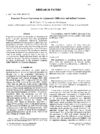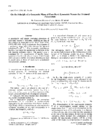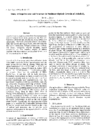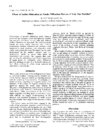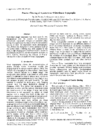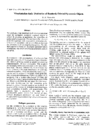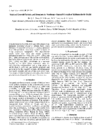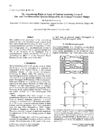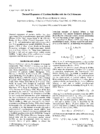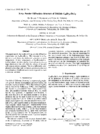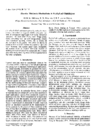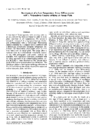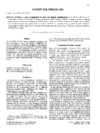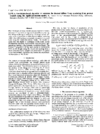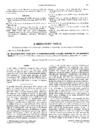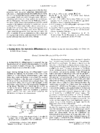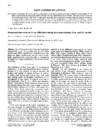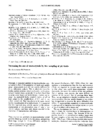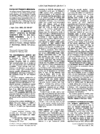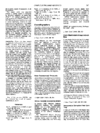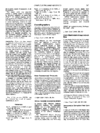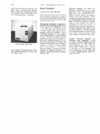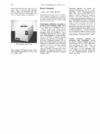issue contents
June 1995 issue

Cover illustration: The observed X-ray diffuse scattering in the (h0l) section of 1,3-dibromo-2,5-diethyl-4,6-dimethylbenzene. Courtesy of T. R. Welberry and B. D. Butler.
research papers
Empirical texture corrections have been generalized to include asymmetric diffraction geometries and inclined textures.
The mathematics of the geometric mean are explained in detail including practicable working formulas and numerical examples.
Ordinary helical inclusion-induced dislocations and dislocation loops and their mobility, electrodomain, growth boundary etc. in crystals of β-BaB2O4 have been studied by X-ray topography. The inclusion formation is discussed in terms of the microphase transition from the β to the α phase or vice versa.
A simple model of surface relaxation in nanocrystals generates powder lines whose Gaussian shapes and asymmetric tails mimic details observed in diffraction patterns of colloidal ferrite particles. This suggests that surface relaxation in nanoparticles can be measured with this old technique.
Fourier filtering is applied to the image analysis of synchrotron white-beam topographs. An optimum filter shape is described that provides accurate filtering without Gibbs diffraction artefacts.
Distributions of misorientation angle of randomly oriented symmetric objects are calculated. They are reference distributions for analysis of misorientations of crystallites in textured polycrystalline materials.
Grown-in dislocations and fringes, inclusions, inclusion-induced dislocations and twinned growth have been studied by X-ray topography, and are discussed in terms of the open structure and structural characteristics in crystals of lithium boric oxide.
The conditions for appearance of the isoscattering points of one-and two-dimensional systems are theoretically derived.
Thermal expansion of caesium halides has been approximated by contributions from a quasiharmonic perfect crystal and its thermal defects. Correction to J. Appl. Cryst. (1995). 28, 306-313.
A novel du Mond configuration for high-resolution X-ray diffraction is described. It uses two channels cut in blocks of silicon to provide high-intensity and high-resolution settings, switching being by linear translation.
Angle calculations and corrections for a new type of diffractometer, which has two degrees of freedom for the sample and two degrees of freedom for the detector, are presented.
This paper describes a triclinic phase of the fullerene derivative of C60Br24 and discusses the transition between it and the high-temperature rhombohedral phase. The structure was solved by Rietveld refinement of a data set taken with synchrotron radiation.
Interfacial disorder in (111)-Fe3O4/CoO multilayers is investigated by X-ray diffraction. Kinematical structure-factor calculations indicate that discrete interfacial disorder explains the observed selective multilayer splitting.
A computer-readable dictionary for protein structure refinement is presented that is based on the set of parameters derived from small-molecule structures. Preliminary results obtained from protein structures refined at atomic resolution are compared with this.
A new type of X-ray apparatus with an image plate as an area detector has been developed in order to study phase transitions at low temperatures. Oscillation and Weissenberg photographs down to 12 K have been taken.
computer programs
The DEMON/ANGEL software suite has been developed for density modification by noncrystallographic symmetry averaging, solvent flattening and histogram mapping
A computer program has been developed to simulate the thermal diffuse scattering from protein crystals. The parameters revealed by this program indicate the coupling of the disorder of the atoms in the protein molecule.
laboratory notes
A device designed primarily for use with monochromatized synchrotron radiation for making comparisons of lattice parameters in different parts of the same crystal, or between two separate crystals, is described.
A heating device for diffractometers is described that uses a hot stream of nitrogen gas to heat the crystal.
fast communications
Picosecond Cu Kα X-ray pulses have been used to probe the lattice of a single gold crystal heated by 10 ps optical pulses. Time resolution of 50 ps has been achieved.
A simple procedure is described that may be useful for increasing the suitability of small crystals of macromolecules for X-ray analysis. It is based on the careful pH titration of mother liquors at the pH limits for the appearance of crystals.
computer program abstracts
The latest upgrade and the sequencing of the widely used DBWS*.* series of programs are described.
crystallographers
Free 

new commercial products
Free 

books received
Free 

Free 

Free 



 journal menu
journal menu









